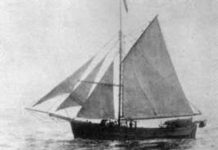The first newspaper in the province, the “Upper Canada Gazette” established in 1793 to disseminate government information, is a valuable historical record.
When Upper Canada was formed under the Constitutional Act of 1791, its first capital was Newark (Niagara-on-the-Lake), and its first Lieutenant-Governor was John Graves Simcoe. With considerable foresight, Simcoe determined that for successful management, the government needed a publication for delivering its decisions to the populace.
“Upper Canada Gazette”
In Lower Canada (Quebec), Simcoe persuaded Louis Roy (apprentice at the Quebec Gazette) to set up a newspaper at Newark. Under administrative control, the Upper Canada Gazette’s primary purpose was to publish government proclamations and notices. It had permission to print local and international items only when there was “a dearth of political intelligence”.
Roy, the first King’s Printer in Upper Canada, published Volume 1, Number 1 of the first newspaper in the province now known as Ontario on Thursday, April 18, 1793. Printed on a wooden screw press, the Upper Canada Gazette was a four-page weekly folio with two main items on its front page:
- Text of King George III December 12, 1792 speech to the Houses of Parliament in London
- Government proclamation to promote virtue and to suppress vice, profanity, and immorality in the province
The winter of 1793 was exceptionally mild and Lake Erie was not frozen over, according to a back page note.
As Newark was considered too close to the United States, Simcoe named York (Toronto) the provincial capital in 1793, but did not move the printing shop. Louis Roy, apparently tired of the drudgery and isolation, returned to work in Montreal in the autumn of 1794.
First Newspaper Publication in York (Toronto)
New Hampshire-born Gideon Tiffany printed his first issue December 3, 1794 with his brother Silvester’s assistance. The interim provincial administration that succeeded Simcoe in 1796 was headed by Executive Council president Peter Russell who replaced Tiffany because of his strong pro-American stance.
Though he was not a printer, new appointee Titus Geer Simons was member of a United Loyalist family, and considered a ‘safe’ individual, but the Executive Council maintained stronger control over presentation of government information.
The October 4, 1798 issue was the first newspaper printed and published in York with the full title, Upper Canada Gazette, or American Oracle, by co-printers William Waters and Titus Simons. In 1799, they became the first officially-designated “Printers to the King’s Most Excellent Majesty”. Both were dismissed in 1801 after mistakenly reporting that influential financier William Allan would be a candidate in an election.
Their replacement John Bennett learned the trade at the Quebec Gazette. He followed the instructions related to government information publication, and, as his predecessors had, printed poems, essays, and miscellaneous pieces as space allowed. He gave the earliest known examples of election campaign literature in the Gazette during 1804, with publication of locations, dates, and results.
Significantly changed by John Cameron, the April 15, 1807 issue printed on larger sheets with four-column layout bore the new name, York Gazette. The paper had increased coverage of local news, and excerpts from British papers.
Printing Press Damaged in 1813
At the outbreak of war between the United States and British North America in 1812, the Gazette increased its news coverage, and published General Isaac Brock’s proclamation alerting York citizens of possible invasion.
In April 1813, the official printing press was severely damaged when the attacking Americans burned the government buildings. While the paper’s publication was suspended, a temporary contract to print laws was awarded to Stephen Miles in Kingston.
Newspaper Divided into Official and News Sections
Army surgeon Dr. Robert Charles Horne, named King’s Printer in 1817, returned the paper to its original name, Upper Canada Gazette. Involved in two controversies related to publication of government information, he disobeyed orders and divided the paper into two sections. In the first, he included all official government material, and in the second, named the York Weekly Post, he printed all other material.
Intellectual Charles Fothergill who became printer in 1822, kept the paper’s two-sections with increased domestic and foreign news. Formerly supportive of the government, Fothergill was dismissed in 1825 by Lieutenant Governor Maitland when, as an elected member of the House, he voted against the government.
Robert Stanton, a former civil employee, held the position of Upper Canada Gazette printer from 1826 until 1841. When he published editorial comments in 1829, the disapproving government restricted him to printing only official business. At that point, Stanton discontinued the second section of the paper which he had printed as U. E. Loyalist for two years.
Upper Canada Gazette Historical Record
When the two Canadas became united in 1841, the Upper Canada Gazette status as official printer was discontinued, although it continued “by authority” until 1849. Richard Watson, the last printer, died at the printing office while attempting to save type during the great Toronto fire in April 1849.
From the time of its inception, and through more than 50 years, the Upper Canada Gazette recorded the development of Toronto from settlement to thriving city and of Ontario from a collection of scattered villages to connected communities.
Sources:
- History of the Book in Canada: Beginnings to 1840 by Patricia Fleming, Gilles Gallichan, Yvan Lamonde, University of Toronto Press Inc., 2004
- The Upper Canada Gazette and Its Printers, 1793-1849 by Brian Tobin, Ontario Legislative Library 1993







